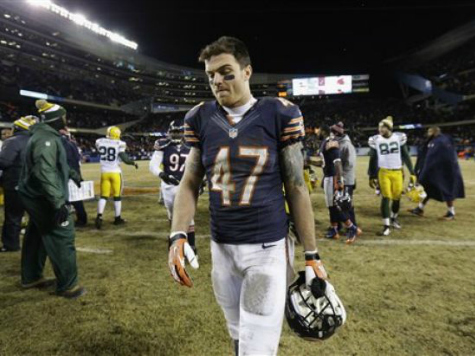Chris Conte, an oft-injured but rarely sidelined-for-long Chicago Bears safety, says he would trade years off his life for NFL longevity.
“As far as after football,” he told the Windy City’s WBBM, “who knows? My life will revolve around football to some point, but I’d rather have the experience of playing and, who knows, die 10, 15 years earlier than not be able to play in the NFL and live a long life. It’s something I’ve wanted to do with my life and I wanted to accomplish. And I pretty much set my whole life up to accomplish that goal. So I don’t really look toward my life after football because I’ll figure things out when I get there and see how I am.”
The premise of the discussion stems from an urban myth. Playing football for a long time actually corresponds with living for a long time. The scribes refuse to embrace the science.
“For all players who play five or more years,” George Will wrote in his column, “life expectancy is less than 60; for linemen, it is much less.” ABC News, the Boston Globe, Malcolm Gladwell, and other leading voices have seconded the falsehood that NFL players die prematurely.
Based on such misinformation, the NFL Players Association petitioned the federal government to conduct a mortality study on professional football players. The National Institute for Occupational Safety and Health (NIOSH) in 2012 reported a mortality rate of 10 percent for NFL veterans who competed in the league for five seasons or more between 1959 and 1988. Comparable men in society suffered from a death rate–18 percent–nearly double that of the athletes.
The scientists expected 147 cancer deaths among the 3,439 NFL veterans they studied based on prevailing rates. They observed just 85. They expected 32 deaths from respiratory illness. They observed six. They expected cardiovascular illness to kill 186. Instead, just 126 players, many of them over 250 pounds, died from heart and circulatory diseases.
Even in the category “diseases of the nervous system and sense organs,” surely a problem area for the football players based on saturation coverage in the press, the scientists discovered 12 deaths where they had predicted 10 based on rates in the surrounding society. Perhaps the two extra deaths points to heightened dangers for collision sports in one area of the body. But 12 deaths instead of ten in brain diseases doesn’t convince the way six deaths instead of 32 in respiratory diseases does. In the illness categories that tend to claim many, many lives, players outperform their peers. In one area that claimed about one-third of one percent of player lives, football players do marginally worse than their non-pro peers.
In all, the federal government’s scientists anticipated 625 deaths. They found 334. In other words 291 guys the scientists expected to be dead were actually alive and well. The one humungous, unavoidable variable separating them from normal men is that they played football at an elite level and for a long time. Sports save lives.
“I’m not saying I’m going to go die when I’m 45, 50,” Conte told radio listeners. “I’m fortunate to go out and play football.” And whether he understands it or not, football–and other vigorous activity–actually helps guys such as Conte to live well past 50.

COMMENTS
Please let us know if you're having issues with commenting.